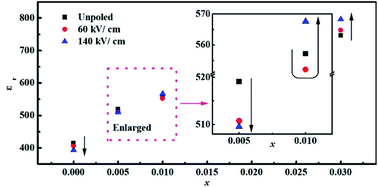Silver niobate based lead-free ceramics with high energy storage density†
Abstract
Antiferroelectrics that display double ferroelectric hysteresis loops have been extensively studied because of their excellent energy storage density compared to normal ferroelectrics and linear dielectrics. Although excellent properties have been achieved in lead-based antiferroelectrics, a feasible replacement for them is urgently needed, with growing concerns on use of lead-containing materials. This work focuses on fabricating AgNbO3-based lead-free antiferroelectric ceramics achieved by co-doping of Bi3+ on the A-site and Zn2+ on the B-site in AgNbO3. These dopants were specifically chosen because of their demonstrated positive influence on energy density and efficiency in AgNbO3 and other lead-free ferroelectric ceramics. The new AgNbO3-based ceramics exhibit a high recoverable energy storage density of 4.6 J cm−3, which is one of the highest values for a lead-free ceramic system reported to date. Co-doping of Bi3+ on the A-site and Zn2+ on the B-site is found to shift the freezing temperature, Tf, to below room temperature stabilizing the antiferroelectric state at room temperature. The increased dielectric breakdown strength, Eb, and electrical displacement, Dm, together with enhanced forward and backward fields are responsible for the high energy storage density. This work shows that a targeted co-doping approach can be an effective strategy for the development of high-performance ceramic capacitors for energy storage applications.



 Please wait while we load your content...
Please wait while we load your content...